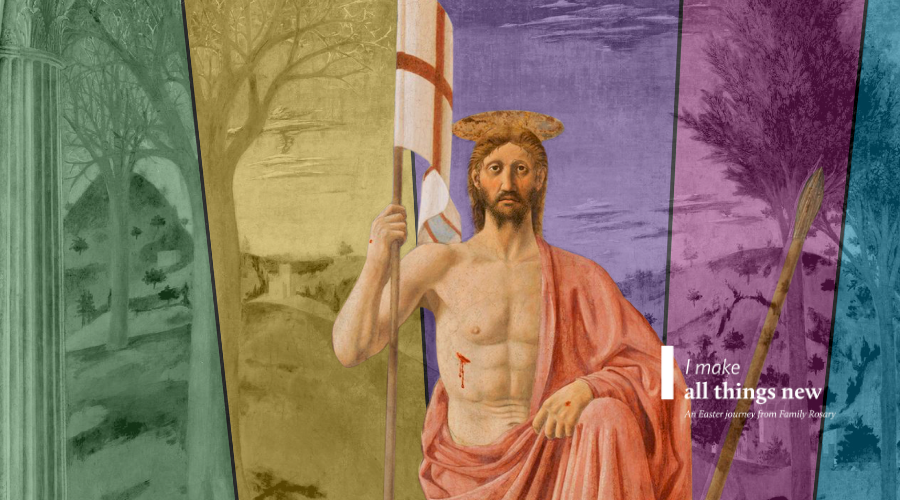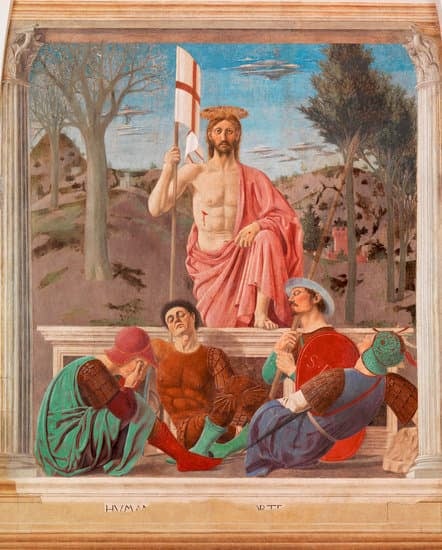
Discovering The Resurrection by Piero della Francesca
Learn more about our faith | Seasonal Reflections
In the 1460’s, the artist Piero della Francesca was hired to create a fresco for the small town of Sansepolcro, Italy. Over seven feet tall, the fresco depicts a life-size Christ rising from His tomb. At the time, Renaissance art usually had Christ floating above the tomb in a display of divine might. But Piero della Francesca chose to depict Christ physically climbing out of His tomb without any fanfare or heavenly aid. This added an air of gravitas and humanism, making The Resurrection of Christ not simply a celebration, but also a reminder of Christ’s sacrifice.
 Christ climbs from the tomb, exhaustion evident in His expression and body language. The flag of the Resurrection is more of a staff for Christ to lean on. This is a man who has a heavy burden on His shoulders, His job not yet complete. He promised to return to mankind, and so He does. But that does mean the journey was easy. Perhaps most startling is Christ’s gaze. He appears to stare straight at the viewer, almost challenging him to deny the truth of His Resurrection.
Christ climbs from the tomb, exhaustion evident in His expression and body language. The flag of the Resurrection is more of a staff for Christ to lean on. This is a man who has a heavy burden on His shoulders, His job not yet complete. He promised to return to mankind, and so He does. But that does mean the journey was easy. Perhaps most startling is Christ’s gaze. He appears to stare straight at the viewer, almost challenging him to deny the truth of His Resurrection.
In this way, Christ is the original action hero, who miraculously returns to win the fight when all seems lost. The message He offers us is clear; He has upheld His promise to save mankind from sin. Christ continues to give all of Himself in our service, and so the duty falls to us to make sure His gift has not been in vain.
The artist chose to focus on Christ’s humanity, but that does not mean the divine is absent. To see the power of His divinity, one must look closer. Christ physically climbs from His tomb, but He is confident that the guards will not waken. The men are asleep, and yet they do not appear to be resting peacefully. They appear very uncomfortable, their bodies contorted – as if they are subconsciously aware that their actions are wrong. Christ, after all, died for their sins, too. He does not strike them down in retribution, but passes them by, letting the knowledge of His Resurrection serve as retribution.
Behind Christ we see more of His divinity at work. The very landscape has changed with Christ’s rise from the tomb. To the left of Christ, we see a barren landscape, with no leaves on the trees and no evidence of life. But on the right side we have a lush landscape and a small town tucked in the hills. It is not a coincidence that this is the same side on which Christ’s foot is placed, as He takes His first step back to mankind and toward the New Creation. As we see in the contrast between the two landscapes, the Resurrection has not destroyed the old creation but rather has healed it and elevated it with supernatural life.
Christ has triumphed over death, and the flag in His hand represents that victory. His body too has miraculously healed. Only the marks of the crucifixion – the proof of His sacrifice – remain. Wounded, yet healed, Christ’s body is evidence that He is both human and divine. It is with this message that He stares into the future, into our very souls that He saved.
The Renaissance in Europe was a time of great social change, whose effect on politics, philosophy, and art can still be seen today. But at its core was a deep, abiding belief in God. This is most obvious in the artwork of the time, including many great religious masterpieces that celebrate Christ. The fresco by Piero della Francesca was painted on the wall of a public meeting hall, a reminder to all officials and politicians that their Savior was watching.
Centuries later, Christ’s message of triumph and hope would again make itself known. During World War II, Sansepolcro was one of many towns that had been occupied by German forces. The Allies responded with terrible bombing raids to free Italy, and this small town was next in line. But a British officer named Tony Clarke went against orders and refused to engage. Though he not seen it himself, Clarke knew that the town held a magnificent piece of Renaissance art. Tony Clarke defied orders because he could not see such a masterpiece destroyed. The town and The Resurrection were saved by Clarke’s decision.
It was soon discovered that the German forces had already abandoned Sansepolcro and Clarke had not only saved a piece of sacred art, but the lives of the townspeople as well.
It is hard not to see the influence of the divine in this incredible tale.
About Caleigh McCutcheon
Caleigh McCutcheon is the curator at the Museum of Family Prayer in North Easton, MA. She has a BA in English from Stonehill College and a MA in Art History from Glasgow University. Her Master’s thesis focused on the complexity and lasting power of the Pieta image in Christian art. She considers art to be one of the most powerful forms of prayer.

